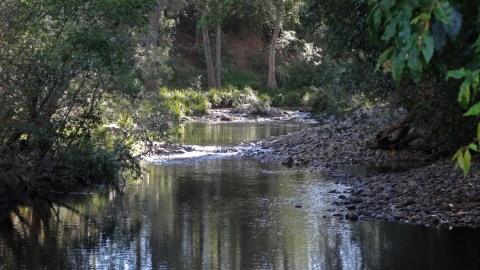- Home
- Assessments
- Bioregional Assessment Program
- Methods
- Assigning receptors to water-dependent assets
- 4 Developing a receptor register
- 4.1 Preparation of product 1.4 (description of the receptor register) and the receptor register
- 4.1.2 Requirements for product 1.4 (description of the receptor register) and the receptor register
The published receptor register and product 1.4 (description of the receptor register) are finalised as follows:
- The Assessment team begins by drafting product 1.4 (description of the receptor register) (see Table 7 for recommended content) and ensuring a refined set of all receptors included in the BA are ready for upload into the Bioregional Assessment Repository as a point dataset (e.g. shapefile).
- The receptor data are checked by the Assessment team and the Bioregional Assessment Information Platform team for the following:
- Every receptor has location attributes (latitude and longitude using the GDA_94 coordinate system).
- Every receptor has a unique ID (BARID, defined as the BA receptor identifier (sequential and unique per receptor across all receptors in the Bioregional Assessment Technical Programme); authoritative source of BARIDs is the Bioregional Assessment Information Platform team).
- Every asset and landscape class is completely and efficiently represented by at least one receptor.
- Any other IDs are maintained and unique, for example RegRID (defined as the BA receptor identifier unique to the specific subregion or bioregion (sequential and unique per receptor across all receptors in the subregion or bioregion); authoritative source of RegRIDs is the Assessment team).
- The receptor register fields (e.g. field names) are formatted consistently with the receptor register template (see Table 6 for recommended content).
- Any other checks needed for either BA analysis or Bioregional Assessment Information Platform needs.
- The Assessment Project Leader must ensure the receptor register dataset is correct and agrees with product 1.4 (description of the receptor register); if not, amendments are made as required.
- The checked version of the receptor register dataset is loaded into the Bioregional Assessment Repository by the Assessment team and the following notified:
- all discipline leads
- the Bioregional Assessment Information Platform team.
- The receptor register spreadsheet is extracted by the Assessment team from the receptor register dataset and formatted according to the receptor register template (see Table 6 for recommended content).
- The final version of product 1.4 (description of the receptor register) and the receptor register spreadsheet is completed for delivery to internal review.
- Any subsequent updates of the receptor register are published on www.bioregionalassessments.gov.au.
Table 6 Recommended content for the receptor register
The receptor register is initially delivered as an Excel spreadsheet entitled Receptor register for the [insert ‘XX subregion’ or ‘YY bioregion’ here] on [DD Month YYYY], with columns as specified in this table. Any subsequent updates are published on the Bioregional Assessment Information Platform.
|
Column heading in spreadsheet |
Description |
Code in point dataset |
|---|---|---|
|
Receptor ID |
The bioregional assessment (BA) receptor identifier (sequential and unique per receptor across all receptors in the Bioregional Assessment Technical Programme) |
BARID |
|
Regional receptor ID |
The bioregional assessment (BA) receptor identifier unique to the specific subregion or bioregion (sequential and unique per receptor across all receptors in the subregion or bioregion) |
RegRID |
|
Latitude |
The latitude of the location of the receptor. The coordinate system is the Geocentric Datum of Australia 1994 (GDA94) |
Latitude |
|
Longitude |
The longitude of the location of the receptor. The coordinate system is the Geocentric Datum of Australia 1994 (GDA94) |
Longitude |
|
Landscape class |
Landscape classes represent areas of similar biophysical characteristics within the subregion or bioregion (see companion submethodology M03 for assigning receptors to water-dependent assets (O'Grady et al., 2016)). |
LandscapeClass |
A large part of this submethodology is superseded by advances in methods for the bioregional assessments (BAs). Specifically, there is now no need to either generate receptors as spatial points across the landscape or to collate them into a receptor register. Instead, receptors are addressed spatially by the asset and landscape class spatial features (polygons, lines and points) and covered conceptually through the development of the landscape classes (product 2.3 (conceptual modelling)), the causal pathways (product 2.3 (conceptual modelling)) and the receptor impact modelling (product 2.7).
Table 7 Recommended content for product 1.4 (description of the receptor register)
A large part of this submethodology is superseded by advances in methods for the bioregional assessments (BAs). Specifically, there is now no need to either generate receptors as spatial points across the landscape or to collate them into a receptor register. Instead, receptors are addressed spatially by the asset and landscape class spatial features (polygons, lines and points) and covered conceptually through the development of the landscape classes (product 2.3 (conceptual modelling)), the causal pathways (product 2.3 (conceptual modelling)) and the receptor impact modelling (product 2.7).

METHODOLOGY FINALISATION DATE
- 1 Background and context
- 2 Defining receptors
- 3 Assigning receptors
- 3.1 Overview of process for assigning receptors
- 3.2 Landscape classification
- 3.3 Process for assigning receptors across the landscape
- 4 Developing a receptor register
- References
- Datasets
- Glossary
- Citation
- Acknowledgements
- Contributors to the Technical Programme
- About this submethodology
